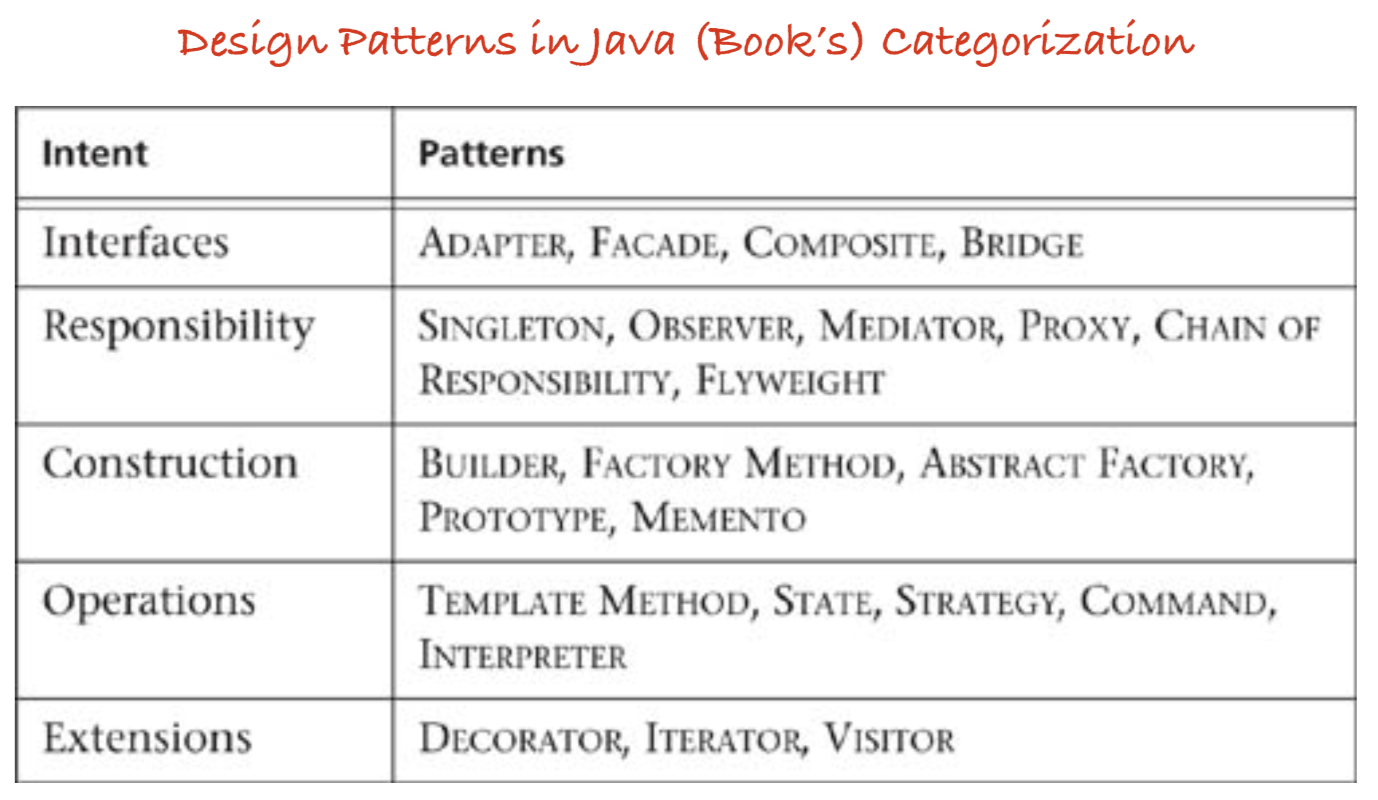202 - Design Pattern
reference: https://refactoring.guru/design-patterns/catalog
Responsibility Driven Design(RDD) : Doing (What I need to do) & Knowing (What I need to know to get my job done)
General Responsibility Assignment Software Patterns (GRASP): controller, creator, indirection, information expert, high cohesion, low coupling, polymorphism, protected variations, and pure fabrication
- Encapsulate the concept that varies
- Adapt to changes without re-design
Classic Gang of Four Patterns Categorization
Purpose: creational, Structural, Behavioral
Scope: Class, Object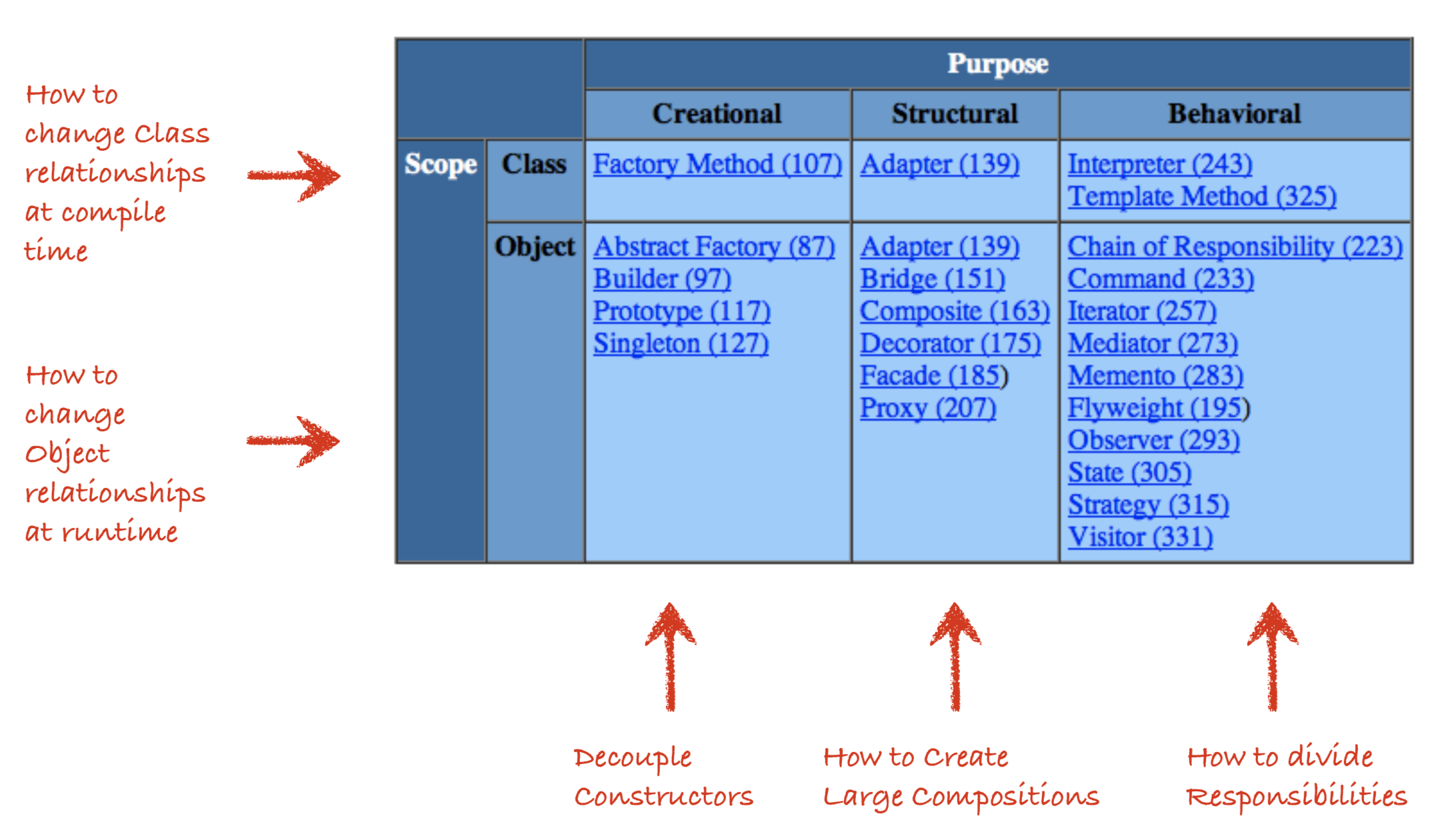
Pattern that defines a skeleton of an Algorithm in an Operation ➜ Template Method
If you have a large number of Observers, it would be better to use this Pattern Instead ➜ Mediator
In the Starbucks Case Study, which of the following objects play the roles of Composites? ➜ Pin Screen
In the Starbucks Case Study, which of the follow Object Play the Role of “Invoker” in the command Pattern? ➜ Menu Option
In the Starbucks Case Study, which of the follow Object Plays the Role of “Receiver” in the command Pattern ➜ None of These
Which pattern complements composite by adding Operations to its Children? ➜ Visitor
MVC
The ideal MVC solution supports the user illusion of seeing and manipulating the domain information directly.
- A model is (a) an object representing data or even activity, e.g. a database table (b) the application object
- A view is (a) some form of visualization of the state of the model. (b) screen presentation
A controller (a) offers facilities to change the state of the model. (b) defines a way the user interface reacts to user input. In Design Patterns/Smalltalk Community, Control Objects are “Mediators”
In UP practice, Control Objects tend to be “God Objects”
MVC decouples Views and Models using a subscribe/notify protocol (Observer)
Views can be nested (Composite)
MVC allows for different ways to respond to user input via a hierarchy of Controllers. (Strategy)
Factory Method - to specify the default controller class
Decorator - to add behavior to a view
Command - to handle menu requests and support undo
Chain of Responsibility - to process action events in nested views
Adapter - to adapt incompatible interfaces for component reuse
Creational: (decouple constructors) Factory Method, Abstract Factory, Builder, Prototype, Singleton
Structural: (create large composition) Adapter, Bridge, Composite, Decorator, Facade, Flyweight, Proxy
Behavioral: (divide responsibilities) Chain of responsibility, Command, Momento, Observer, State, Strategy, Iterator, Mediator, Template, Visitor
Creational -- (decouple constructors)
Responsible for efficient object creation mechanisms, which increase the flexibility and reuse of existing code.
Class (change class relationships at compile time)
✦ Differences between Abstract Factory Pattern and Factory Method:
The main difference between a "factory method" and an "abstract factory" is that the factory method is a single method, and an abstract factory is an object.
Because the factory method is just a method, it can be overridden in a subclass, hence
... the Factory Method pattern uses inheritance and relies on a subclass to handle the desired object instantiation.
The quote assumes that an object is calling its own factory method here. Therefore the only thing that could change the return value would be a subclass.
The abstract factory is an object that has multiple factory methods on it.
... with the Abstract Factory pattern, a class delegates the responsibility of object instantiation to another object via composition ...
What they're saying is that there is an object A, who wants to make a Foo object. Instead of making the Foo object itself (e.g., with a factory method), it's going to get a different object (the abstract factory) to create the Foo object.
Code Examples
here is a factory method in use:
class A {
private Factory factory;
public A(Factory factory) {
this.factory = factory;
}
public void doSomething() {
//The concrete class of "f" depends on the concrete class
//of the factory passed into the constructor. If you provide a
//different factory, you get a different Foo object.
Foo f = factory.makeFoo();
f.whatever();
}
}
interface Factory {
Foo makeFoo();
Bar makeBar();
Aycufcn makeAmbiguousYetCommonlyUsedFakeClassName();
}
//need to make concrete factories that implement the "Factory" interface here
And here is an abstract factory in use:
class A {
public void doSomething() {
Foo f = makeFoo();
f.whatever();
}
protected Foo makeFoo() {
return new RegularFoo();
}
}
class B extends A {
protected Foo makeFoo() {
//subclass is overriding the factory method
//to return something different
return new SpecialFoo();
}
}
Factory Method
is a creational design pattern that provides an interface for creating objects in superclass, but allow subclasses to alter the type of objects that will be created.
Subclass of object that is instantiated can vary
Purpose
Exposes a method for creating objects, allowing subclasses to control the actual creation process.
Use When
A class will not know what classes it will be required to create.
Subclasses may specify what objects should be created.
Parent classes wish to defer creation to their subclasses.
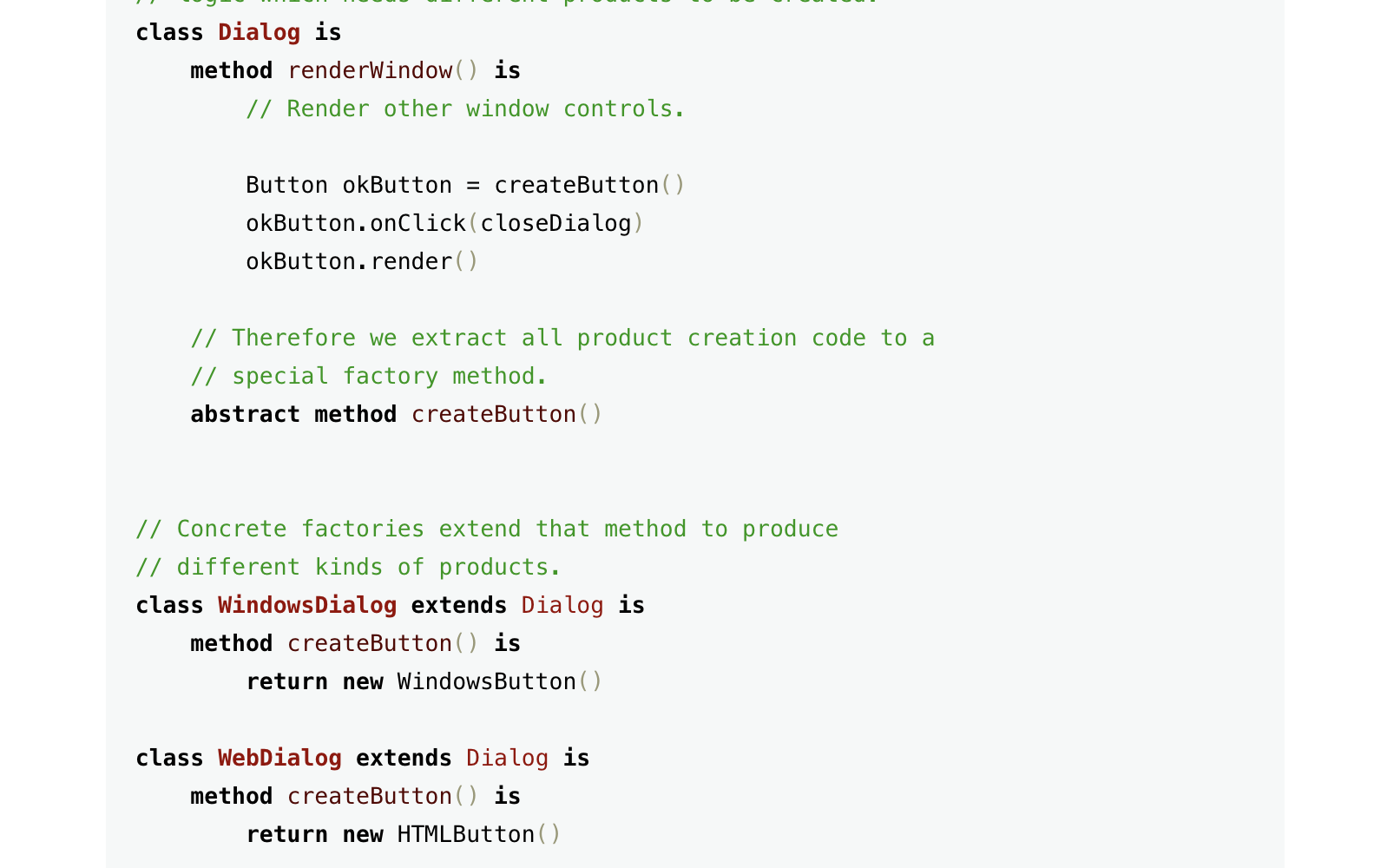
object (change object relationships at runtime)
Abstract Factory
is a creational design pattern that lets you produce families of related objects without specifying their concrete classes.
Families of product objects can vary
Purpose
Provide an interface that delegates creation calls to one or more concrete classes in order to deliver specific objects.
Use When
The creation of objects should be independent of the system utilizing them.
Systems should be capable of using multiple families of objects.
Families of objects must be used together.
Libraries must be published without exposing implementation details.
Concrete classes should be decoupled from clients.
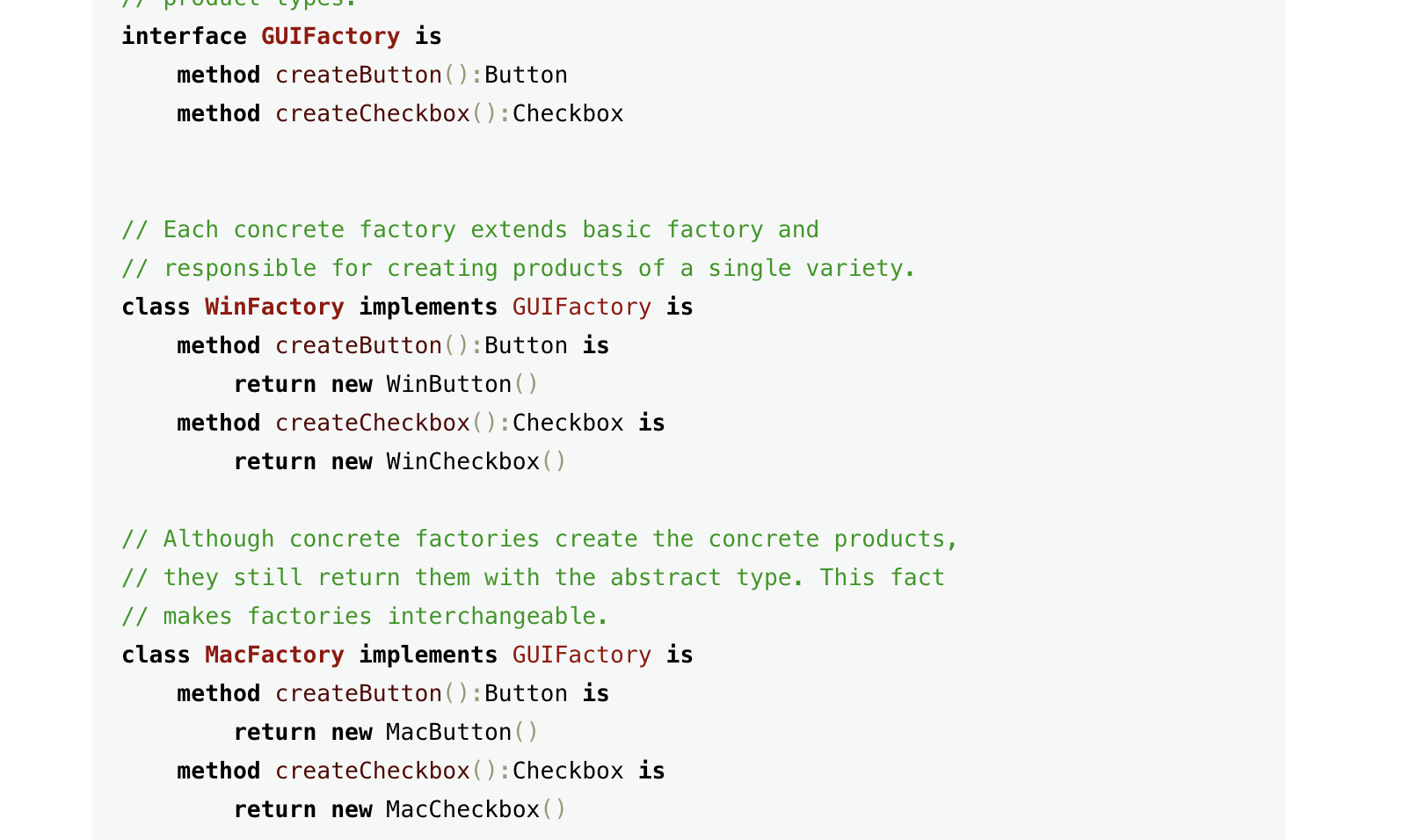
Builder
is a creational design pattern that lets you produce different types and representations of an object using the same building process. Builder allows constructing complex objects step by step.
How a composite object gets created can vary
Purpose
Allows for the dynamic creation of objects based upon easily interchangeable algorithms.
Use When
Object creation algorithms should be decoupled from the system.
Multiple representations of creation algorithms are required.
The addition of new creation functionality without changing the core code is necessary.
Runtime control over the creation process is required.
director = new Director();
CarBuilder builder = new CarBuilder();
director.constructSportsCar(builder);
Car car = builder.getResult();
Prototype
is a creational design pattern that lets you produce new objects by copying existing ones without compromising their internals.
Class of object that is instantiated can vary
Purpose
Create objects based upon a template of an existing objects through cloning.
Use When
Composition, creation, and representation of objects should be decoupled from a system.
Classes to be created are specified at runtime.
A limited number of state combinations exist in an object.
Objects or object structures are required that are identical or closely resemble other existing objects or object structures.
The initial creation of each object is an expensive operation.
private Shape clone() {
return new Circle(this);
}
- Singleton
is a creational design pattern that lets you ensure that a class has only one instance and provide a global access point to this instance.
The sole instance of a class can vary
Purpose
Ensures that only one instance of a class is allowed within a system.
Use When
Exactly one instance of a class is required.
Controlled access to a single object is necessary.
Structural -- (create large composition)
Responsible for building simple and efficient class hierarchies and relations between different classes.
Class (change class relationships at compile time)
Adapter
is a structural design pattern that allows objects with incompatible interfaces to collaborate.
Interface to an object can vary
Purpose
Permits classes with disparate interfaces to work together by creating a common object by which they may communicate and interact.
Use When
A class to be used doesn’t meet interface requirements.
Complex conditions tie object behavior to its state.
Transitions between states need to be explicit.
public class SquarePegAdapter extends RoundPeg {
private SquarePeg peg;
public SquarePegAdapter(SquarePeg peg) {
this.peg = peg;
}
public SquarePeg getRadius(){
// Get half of the diagonal's length using the Pythagorean equation.
return Math.sqrt(2 * Math.pow(peg.getWidth(), 2))/ 2;
}
}
object (change object relationships at runtime)
Bridge
is a structural design pattern that lets you split a giant class or a set of closely related classes into two separate hierarchies, abstraction and implementation, which can be developed independently of each other.
Implementation of an object can vary, let abstractions and implementations vary independently
Purpose
Defines an abstract object structure independently of the implementation object structure in order to limit coupling.
Use When
Abstractions and implementations should not be bound at compile time.
Abstractions and implementations should be independently extensible.
Changes in the implementation of an abstraction should have no impact on clients.
Implementation details should be hidden from the client.
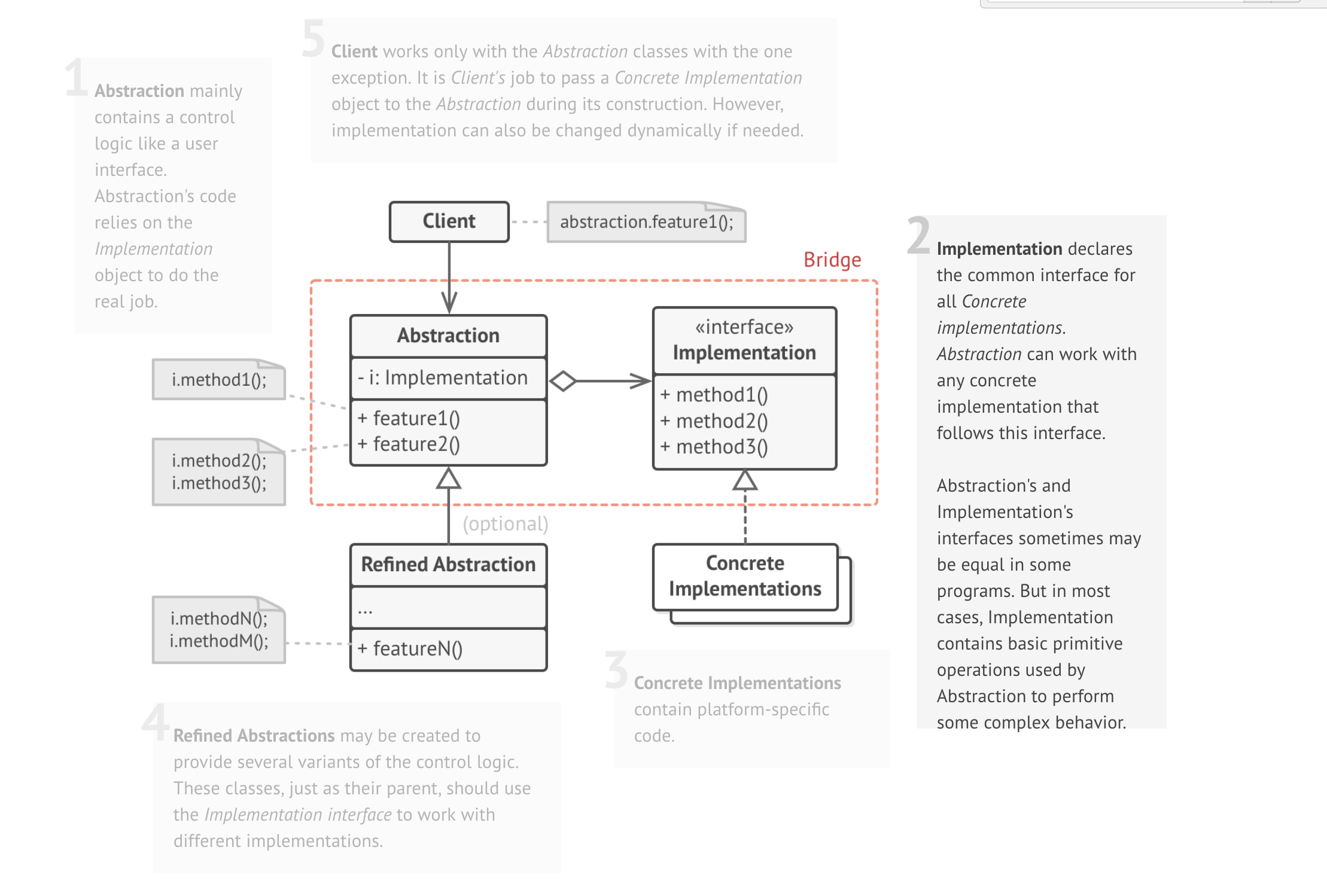
Composite
is a structural design pattern that lets you compose objects into tree structures and allow clients to work with these structures as if they were individual objects.
Structure and composition of an object can vary
Purpose
Facilitates the creation of object hierarchies where each object can be treated independently or as a set of nested objects through the same interface.
Use When
Hierarchical representations of objects are needed.
Objects and compositions of objects should be treated uniformly.
Decorator (Wrapper)
is a structural design pattern that lets you attach new behaviors to objects by placing them inside wrapper objects that contain these behaviors.
Responsibilities of an object without subclassing can vary
Purpose
Allows for the dynamic wrapping of objects in order to modify their existing responsibilities and behaviors.
Use When
Object responsibilities and behaviors should be dynamically modifiable.
Concrete implementations should be decoupled from responsibilities and behaviors.
Subclassing to achieve modification is impractical or impossible.
Specific functionality should not reside high in the object hierarchy.
A lot of little objects surrounding a concrete implementation is acceptable.
Facade
is a structural design pattern that lets you provide a simplified interface to a complex system of classes, library or framework.
Interface to a subsystem can vary
Purpose
Supplies a single interface to a set of interfaces within a system.
Use When
A simple interface is needed to provide access to a complex system.
There are many dependencies between system implementations and clients.
Systems and subsystems should be layered.
Flyweight
is a structural design pattern that lets you fit more objects into the available amount of RAM by sharing common parts of object state among multiple objects, instead of keeping it in each object.
Purpose
Facilitates the reuse of many fine grained objects, making the utilization of large numbers of objects more efficient.
Use When
Many like objects are used and storage cost is high.
The majority of each object’s state can be made extrinsic.
A few shared objects can replace many unshared ones.
The identity of each object does not matter.
- Divide fields of a class that should become a flyweight into two parts:
- intrinsic state: fields that contain unchanging data, duplicate across many objects;
- extrinsic state: fields that contain contextual data, unique for all objects
Proxy (Surrogate)
is a structural design pattern that lets you provide a substitute or placeholder for another object to control access to it.
How an object is accessed can vary; its location can vary
Purpose
Allows for object level access control by acting as a pass through entity or a placeholder object.
Use When
The object being represented is external to the system.
Objects need to be created on demand.
Access control for the original object is required.
Added functionality is required when an object is accessed.
Behavioral (divide responsibilities)
Responsible for the efficient and safe distribution of behaviors among the program's objects.
Class (change class relationships at compile time)
Iterator
is a behavioral design pattern that lets you access the elements of an aggregate object sequentially without exposing its underlying representation.
Purpose
Allows for access to the elements of an aggregate object without allowing access to its underlying representation.
Use When
Access to elements is needed without access to the entire representation.
Multiple or concurrent traversals of the elements are needed.
A uniform interface for traversal is needed.
Subtle differences exist between the implementation details of various iterators.
Template Method
is a behavioral design pattern that lets you define the skeleton of an algorithm and allow subclasses to redefine certain steps of the algorithm without changing its structure.
Purpose
Identifies the framework of an algorithm, allowing implementing classes to define the actual behavior.
Use When
A single abstract implementation of an algorithm is needed.
Common behavior among subclasses should be localized to a common class.
Parent classes should be able to uniformly invoke behavior in their subclasses.
Most or all subclasses need to implement the behavior.
object (change object relationships at runtime)
Chain of Responsibility
is a behavioral design pattern that lets you avoid coupling the sender of a request to its receiver by giving more than one object a chance to handle the request. Chain the receiving objects and pass the request along the chain until an object handles it.
Purpose
Gives more than one object an opportunity to handle a request by linking receiving objects together.
Use When
Multiple objects may handle a request and the handler doesn’t have to be a specific object.
A set of objects should be able to handle a request with the handler determined at runtime.
A request not being handled is an acceptable potential outcome.
Command
is a behavioral design pattern that lets you turn a request into stand-alone object, which can be used to parametrize objects with different requests, queue or log requests, and support undoable operations.
Purpose
Encapsulates a request allowing it to be treated as an object. This allows the request to be handled in traditionally object based relationships such as queuing and callbacks.
Use When
You need callback functionality.
Requests need to be handled at variant times or in variant orders.
A history of requests is needed.
The invoker should be decoupled from the object handling the invocation.
Mediator
is a behavioral design pattern that lets you define an object that encapsulates relations between a set of objects to make them independent of each other.
Purpose
Allows loose coupling by encapsulating the way disparate sets of objects interact and communicate with each other. Allows for the actions of each object set to vary independently of one another.
Use When
Communication between sets of objects is well defined and complex.
Too many relationships exist and common point of control or communication is needed.
Memento
is a behavioral design pattern that lets you capture the object's internal state without exposing its internal structure, so that the object can be returned to this state later.
Purpose
Allows for capturing and externalizing an object’s internal state so that it can be restored later, all without violating encapsulation.
Use When
The internal state of an object must be saved and restored at a later time.
Internal state cannot be exposed by interfaces without exposing implementation.
Encapsulation boundaries must be preserved.
Observer
is a behavioral design pattern that lets you define a one-to-many dependency between objects so that when one object changes state, all its dependents are notified and updated automatically.
Purpose
Lets one or more objects be notified of state changes in other objects within the system.
Use When
State changes in one or more objects should trigger behavior in other objects
Broadcasting capabilities are required.
An understanding exists that objects will be blind to the expense of notification.
State
is a behavioral design pattern that allows an object to alter its behavior when its internal state changes. The object will appear to change its class.
Purpose
Ties object circumstances to its behavior, allowing the object to behave in different ways based upon its internal state.
Use When
The behavior of an object should be influenced by its state.
Complex conditions tie object behavior to its state.
Transitions between states need to be explicit.
Strategy
is a behavioral design pattern that lets you define a family of algorithms, encapsulate each one, and make them interchangeable. Strategy lets the algorithm vary independently from the clients that use it.
Purpose
Defines a set of encapsulated algorithms that can be swapped to carry out a specific behavior.
Use When
The only difference between many related classes is their behavior.
Multiple versions or variations of an algorithm are required.
Algorithms access or utilize data that calling code shouldn’t be exposed to.
The behavior of a class should be defined at runtime.
Conditional statements are complex and hard to maintain.
Visitor
is a behavioral design pattern that lets you define a new operation without changing the classes of the objects on which it operates.
Purpose
Allows for one or more operations to be applied to a set of objects at runtime, decoupling the operations from the object structure.
Use When
An object structure must have many unrelated operations performed upon it.
The object structure can’t change but operations performed on it can.
Operations must be performed on the concrete classes of an object structure.
Exposing internal state or operations of the object structure is acceptable.
Operations should be able to operate on multiple object structures that implement the same interface sets.
